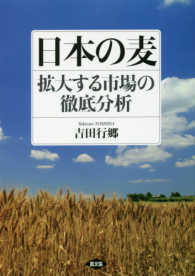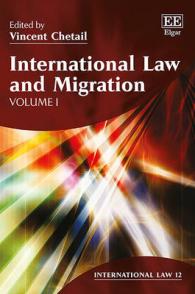Full Description
"Annual Editionscurrent articles selected from the best of the public press. Organizational features include: an annotated listing of selected World Wide Web sites; an annotated table of contents; a topic guide; a general introduction; brief overviews for each section; a topical index; and an instructor's resource guide with testing materials. "Using Annual Editions in the Classroom" is offered as a practical guide for instructors. "Annual Editions" titles are supported by our student website.
Contents
UNIT 1. Styleal., American Cinematographer, May 2003 Conrad Hall (1926-2003), one of Hollywood's most respected cinematographers, reminisces about some of his major films and his approach to the "formal reality" of the film world. 2. The Emergence of Filmic Artifacts: Cinema and Cinematography in the Digital Era, Stephen Prince, Film Quarterly, Spring 2004 The tools of digital filmmaking have transformed cinematography, but Prince argues that the changes wrought by such technology are more subtle and profound than the "in-your-face" special effects found in big-budget films. 3. Intensified Continuity: Visual Style in Contemporary American Film, David Bordwell, Film Quarterly, Spring 2002 Despite what often appears to be narrative incoherence and/or stylistic fragmentation, recent mainstream American films still tend to follow the guidelines of the classical Hollywood style that emerged during the first half of the twentieth century; what has occurred is an intensification of long-established techniques. 4. Sound Doctrine: An Interview with Walter Murch, Michael Jarrett, Film Quarterly, Spring 2000 Using examples from several of his films, sound designer (and film editor) Walter Murch explains that well-crafted motion picture sound can prompt us to "hear" the world differently, just as paintings can help us see the world from a new perspective. 5. The Sound of Film Acting, Pamela Robertson Wojcik, Journal of Film and Video, Spring 2006 Wojcik argues that digitally created characters like Gollum in Lord of the Rings should prompt us to reconsider the long-held view that voice acting is somehow inferior to performances that involve the actor's "real" body. 6. Yes, It's Been an Auteur's World. But Writers May Yet Get Their 'Film by' Due, David Kipen, Los Angeles Times, February 5, 2006 Directors are typically considered the "authors" of films, but Kipen argues that the artistic contributions made by screenwriters may be more essential to the filmmaking process. 7. Screenwriting with Your Eyes: An Interview with Suso Cecchi d'Amico, A.G. Basoli, Cineaste, Fall 2002 Suso Cecchi d'Amico, author of many classic Italian films, explains that screenwriters must always consider how their words will function as moving images. 8. Text, Lies and Celluloid, Jason Anderson, This Magazine, November/December 2005 An adaptation of a novel or other literary source should not be judged simply by its faithfulness to the original source, but on how well the filmmakers create a unique cinematic reading of the text. 9. Men with Swords and Men with Suits: The Cinema of Akira Kurosawa, Catherine Russell, Cineaste, Winter 2002 Often acknowledged as Japan's greatest director, Kurosawa incorporated Japanese traditions, Western literature, and Hollywood style into his films. 10. Lost Horizons, Howard Hampton and Chris Darke, Film Comment, May/June 2003 Hampton considers the career of legendary avant-garde filmmaker Chris Marker, whose fascinating work has explored the complexities of time, memory, language, and images. 11. The Doyen of Direct Cinema, David E. Williams, American Cinematographer, February 2006 Respected documentarian Frederick Wiseman pioneered an unobtrusive approach to nonfiction filmmaking involving simple, stark recording of subjects without the use of voice-over narration, interviewing, or music. UNIT 2. Form: Film Modes and Genres 12. Stylistic Crossings: Cyberpunk Impulses in Anime, Jane Chi Hyun Park, World Literature Today, September-December 2005 Park examines the influence of cyberpunk elements on anime, a form of stylized, colorful Japanese animation typically based on manga (graphic novels). 13. Pixar Perfect: Does the Computer Make Cinema More Real?, Rene Daalder, Modern Painters, November 2005 Pixar has demonstrated that the expressiveness of digital animation can catalyze creativity, allowing artists to surpass the limits of live-action cinema. 14. Feel the Pain, Paul Arthur, Film Comment, September/October 2004 It has become more and more common for nonfiction filmmakers to clarify and resolve their psychosocial problems on-screen, but have first-person documentaries gone too far? 15. The Real Deal, Katerina Cizek, This Magazine, November/December 2005 Greater access to video cameras and the Internet has prompted more documentary production than ever before; we can all participate in the retelling and reinventing of human reality. 16. We Will Not Go Quietly: Some Thoughts on the Avant-Garde, Then and Now, Willie Varela, Journal of Film and Video, Spring 2005 As moving-image technology evolves and popular culture becomes increasingly wedded to commercial, narrative filmmaking, artists who refuse to work within an established set of codes have an important role to play in the future of cinema. 17. African Cinemas, Teresa Hoefert De Turegano, World Literature Today, October/December 2003 Sub-Saharan African filmmaking, while it is very diverse in terms of genres and aesthetics, focuses upon conflicts between the old and new-the artistic identity crises wrought by colonization-and the importance of individual morality. 18. Brazilian Cinema: Film in the Land of Black Orpheus, Glauco Ortolano and Julie A. Porter, World Literature Today, October/December 2003 Brazil has played a key role in international cinema, especially in its production of self-reflexive, visually poetic, anti-establishment films such as the recent Cidade de Deus (City of God; 2002). 19. Bollywood Spectaculars, Priya Jaikumar, World Literature Today, October/December 2003 India produces more films than any other country in the world, many of them made in Bollywood (Mumbai, formerly Bombay). Bollywood films are musicals with spectacular visuals and a loose narrative structure, which means that they are very different from most American genre films. 20. Spirit Levels, Mark Kermode, Sight and Sound, August 2005 Remaking Japanese horror flicks has become popular in Hollywood, but Mark Kermode argues that some elements of such films are untranslatable, perhaps because Japanese and American cultures have divergent approaches to the spirit world. 21. Horror Show, Devin Gordon, Newsweek, April 3, 2006 In recent years Hollywood horror films have gotten increasingly sadistic. Should this gorefest be dismissed as "torture porn," or is it a subversive commentary on a post-9/11 world? 22. Creating and Comparing Myth in Twentieth-Century Science Fiction: Star Trek and Star Wars, Lincoln Geraghty, Film Literature Quarterly, Fall 2005 Star Trek and Star Wars use myths to create their own versions of an alternate reality, but they also represent contemporary trends and tastes. 23. The Corleone Chronicles, Phoebe Poon, Journal of Popular Film and Television, Winter 2006 Poon argues that Francis Ford Coppola's Godfather series should be evaluated not just as two outstanding gangster films that were followed by a disappointing third entry, but as a trilogy that has its own narrative and structural unity. UNIT 3. Economics: Film as an Industry 24. The Death of Film/The Decay of Cinema, Godfrey Cheshire, New York Press, August 26, 1999 As film is inexorably eclipsed by digital technology, the most immediate change that we can expect is video projection in movie theaters. Will something fundamental be lost when we no longer screen films on celluloid? 25. The Big Picture: In a Losing Race with the Zeitgeist, Patrick Goldstein, Los Angeles Times, November 22, 2005 Hollywood is facing a decline in movie attendance that may signal the end of films as a "mass audience ritual"-and studios are locked into a corporate mind -set that does not take creative advantage of new distribution technologies. 26. Distribution Options Blossom for Indies, Stephanie Argy, American Cinematographer, March 2006 DVDs, the Internet, and iPods are important distribution avenues for independent filmmakers. 27. Cannes 2006: American Decadence and Other Tales, Nick James, Sight and Sound, July 2006 According to James, the 2006 edition of the most famous film festival in the world served to dash hopes and batter established reputations. 28. Report on the First Ramallah International Film Festival, Kay Dickinson, Screen, Summer 2005 Media representations of the West Bank city of Ramallah undermine the notion that it would be a suitable location for a large film festival, but there is much to be gained from the interaction of Palestinians and international film cultures. 29. The British Film Debate: Introduction, Sarah Street, Screen, Spring 2005 The British film industry has been dogged by "small-thinking, aesthetic conservatism and small box-office takings." Is the situation ripe for change? 30. Images on the Move: Reframing the Cinemas of Europe, Wendy Everett, Screen, Spring 2005 As Europe adopts a multiethnic, multicultural way of life, it has the potential to produce outstanding films that go beyond the formulaic and move toward open-endedness, dynamism, and innovation. 31. The Lost Picture Show, Brian D. Johnson, Maclean's, April 17, 2006 According to Johnson, the English Canadian film industry is in a crisis, producing obscure films with flashes of brilliance but no widespread appeal. 32. Chip Off the Old Block, Graham Leggat, Film Comment, November/December 2004 Video games have gone mainstream, and there is an increasing crossover of talent and influence between the film and game industries. 33. Bleary Days for Eyes on the Prize/Cash Rescues Eyes on the Prize, Katie Dean, www.wired.com, December 22, 2004/August 30, 2005 Until the Ford Foundation and a private philanthropist stepped forward, Eyes on the Prize, a landmark civil rights documentary, could no longer be broadcast and sold in the United States because the rights to some of the archival footage used in the film had expired and were prohibitively expensive to renew. UNIT 4. Ideology: Film and/in the World 34. International Film Criticism Today: A Critical Symposium, Cineaste, Winter 2005 Film critics from Argentina, Australia, Austria, Brazil, China, and France answer three questions about their work: 1) What does being a film critic mean to you? 2) What qualities make for a memorable film critic? 3) How do you assess (or combat) the perceived globalization of the film industry? 35. Everyone's Always Been a Critic-but the Net Makes Their Voices Count, Scott Kirsner, The Boston Globe, April 30, 2006 Expert opinion used to drive film and media culture, but now recommendations by Internet bloggers are becoming increasingly influential. 36. Domesticated Violence, Bert Cardullo, The Hudson Review, Winter 2006 Senegalese filmmaker Osmane Sembene examines the traditional African practice of female genital mutilation, acknowledging its ritualistic and complex nature. 37. Grizzly Man, Conrad Geller, Cineaste, Winter 2005 German filmmaker Werner Herzog uses video blogs, interviews, and audio commentary to create a "strange" and "harrowing" portrait of naturalist Timothy Treadwell, who felt it was his destiny to save Alaskan grizzly bears-and was ultimately killed by one of them. 38. 2046: A Matter of Time, A Labour of Love, Stephen Teo, www.sensesofcinema.com, April/June 2005 2046 completes a trilogy by celebrated Hong Kong filmmaker Wong Kar-wai that deals with love in the 1960s. His latest film features the director's customary fragmented, episodic method of storytelling, which in this instance operates in a futuristic location where people can go to recover lost memories. 39. Fear of a Black Cinema, Amy Taubin, Sight and Sound, August 2002 Taubin argues that Do the Right Thing (1989) deserves recognition for its unvarnished portrayal of racism as well as its ingenious stylistic flourishes. 40. Where Are the Female Directors?, Michelle Goldberg, www.salon.com, August 27, 2002 Women have made inroads in many avenues of filmmaking, but virtually all directors of mainstream or independent American films are still male. Many factors-including economics, sexism, the tastes of executives, and even self-sabotage-are contributing to the inequity. 41. Not Quitting Brokeback, Richard Schneider, Jr., The Gay and Lesbian Review, May/June 2006 Four cultural critics consider the means by which Brokeback Mountain strips bare gay stereotypes and may (or may not) herald a new era in the cinematic representation of homosexuality. 42. G Movies Give Boys a D: Portraying Males as Dominant, Disconnected and Dangerous, Joe Kelly and Stacy L. Smith, www.seejane.org, May 2006 G-rated movies are dominated by aggressive white male characters who are seldom in significant relationships with other characters. 43. Inventing Historical Truth on the Silver Screen, Robert A. Rosenstone, Cineaste, Spring 2004 Though it may seem counterintuitive, the process of invention (fictionalization) is a strength rather than a weakness of good historical filmmaking. 44. Digging Deepa, Andre Mayer, www.cbc.ca/arts, November 3, 2005 Controversial filmmaker Deepa Mehta portrays human degradation in an ashram-or widow colony-in 1938 India, immersing viewers in the "lush colours and customs of Indian culture" while confronting a painful part of the nation's past. 45. Invaded by Memories of Germany's Past: An Interview with Margarethe von Trotta, Robert Sklar, Cineaste, Spring 2004 Widely recognized German filmmaker Margarethe von Trotta fictionalizes a 1943 incident in which protests in the city of Berlin prompted Nazis to grant a reprieve from persecution to German Jews who were married to non-Jews or who had one non-Jewish parent. 46. Did Al Get the Science Right?, Katharine Mieszkowski, www.salon.com, June 10, 2006 An Inconvenient Truth tackles the issue of global warming. Climate scientists who have seen the film say that, on the whole, it "does a good job of presenting what's likely to occur if human-induced greenhouse gas emissions continue unabated." 47. Auditioning Betty in Mulholland Drive, George Toles, Film Quarterly, Fall 2004 Toles argues that Betty's "astonishing" audition scene demonstrates how Hollywood star acting can achieve a mysterious, "boundary-shattering" control over audiences. 48. In Search of a Star: Kinuyo Tanaka, William Johnson, Film Comment, January 1994 Kinuyo Tanaka, one of Japan's greatest film stars, developed a persona that combined contradictory themes such as divinity and commonality, adventure and domesticity. 49. Censorship and Indian Cinema, Shammi Nanda, www.brightlightsfilm.com, November 2002 Films released in India must have a certificate from the Censor Board; Nanda argues that the Board approves conservative, reactionary films and cuts or suppresses progressive cinema. 50. Three Decades of Film Censorship...Right Before Your Eyes, Chris Roth, The Humanist, January/February 2000 The film-rating system in the United States is not law and is not designed to proscribe motion picture content, but in practice it does limit the material that is presented in American movies, resulting in a situation of "censorship by ratings." 51. Lights, Camera, Action. Marxism, Semiotics, Narratology, David Weddle, Los Angeles Times, July 13, 2003 In recent decades, film theory has become increasingly dense and complex. Is it simply an arcane language, or does it offe r essential truths about motion pictures and our experience of watching them? 52. Is a Cinema Studies Degree the New M.B.A.?, Elizabeth Van Ness, The New York Times, March 6, 2005 Film schools are now attracting students who view cinema as a basic professional language-like writing or public speaking-that can be used to establish and consolidate social, economic, and political power.NER(01): WOW








